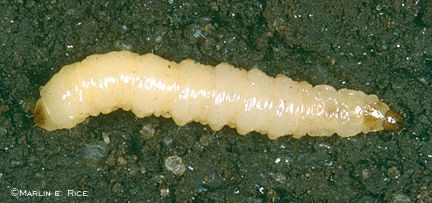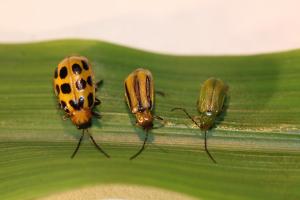By Madelyn DeJong
AgVenture Product Marketing Intern
It is now that time of year again to be thinking about what kind of pests could be threatening your crops. One pest in particular? Corn rootworms. Being proactive will protect your crops and your yield when harvest comes this fall.
Corn rootworm larvae begins hatching in late May to June. “Generally, corn rootworm hatch occurs close to the time that we begin seeing lightning bugs outside in the evenings,” said AgVenture Agronomy Lead Louis Sutton. “This is not 100% true, but it gives us a good indication of the hatch timing. When this happens, set a reminder to begin scouting in the next couple of weeks.”
These newly hatched larvae will begin to feed on corn roots, and damage to the roots can lead to multiple problems for the corn plant. These problems include susceptibility to lodging and drought stress, which all lead to a loss in yield. If corn rootworm larvae reach the adult stage, feeding on silks may occur, resulting in unpollinated kernels.
To avoid these issues and achieve the best yield possible, it is best to begin looking for corn rootworm now. “The best way to find rootworm larvae is by soaking the root ball of the corn plant in a bucket of water, then waiting 5-10 minutes before counting the larvae that float to the top,” Sutton advised. A few keys to prevention include crop rotation, crop scouting and insecticide use.
Here’s how to identify corn rootworm and its damage on crops:
Corn Rootworm eggs are white/cream in color and oval shaped. Larvae are usually white with a brown head, and under a ½ inch when fully grown.
Adult Western Corn Rootworm have 3 black stripes that do not extend to abdomen with a yellow body. WCR may be confused with the cucumber beetle, whose strips extend to the abdomen and have a black underbelly. Northern Corn Rootworm is all green, usually with no other markings. Southern Corn Rootworm is yellow/green with 12 black spots. It is easily confused with bean leaf beetle that only has 4 black spots.
As the growing season continues, you will be able to identify damage caused by adult beetles. Roots that have been feed on by corn rootworm larvae will have discoloration with brownish scars, they will also appear tunneled into. Adults will cause foliar damage, giving a parchment look to damaged areas on leaves. They can also be found feeding on corn silks when it has reached that stage.
To create a field-specific Corn Rootworm management plan, contact your AgVenture Yield Specialist.
Find your local, independently owned seed company: https://agventure.com/findagventure/



